Design of a Low-Cost Gateway with LoRa Technology Serving Multiple Devices
Abstract
1. Introduction
2. Background
2.1. Synopsis of LoRa Technology
- BW—Bandwidth: There are three predominant bandwidths used for transmission: 125, 250, and 500 KHz. The selected frequency range will be the one over which the LoRa chirp spreads. The higher the bandwidth, the greater the data rate of the packets; consequently, the transmission range decreases [26,29].
- CR—Error Correction Rate: The value set for CR corresponds to the number of bits added to the packet header to perform error correction techniques. When higher coding rates are defined, their robustness to interference significantly increases; however, the packet length increases along with the transmission time and power consumption [26,30].
- Preamble: The first part of the structure is used to synchronize the receiver with the data stream being transmitted through a sequence of symbols. For intensive reception, more symbols are required to reduce the duty cycle on the receiver, thus saving energy.
- Header: The header can be configured in an explicit or implicit manner. The explicit form transmits the encoding settings, payload size, and the presence of the cyclic redundancy check (CRC) field. However, the transmission time will be relatively longer compared to the implicit mode, which assumes these configurations are fixed and does not require their transmission.
- Payload: The payload is where the desired data is sent, encoded based on the error rate specified in the explicit header or the known rate when used in implicit mode. The length of the payload can be configurable, and an optional CRC can be added at the end. The amount of transmitted bytes influences the transmission time, along with the chosen SF for operation.
2.2. Synopsis of the LoRaWAN Protocol
- Class A: This encompasses sensors that have the ability to receive data in predetermined time windows, immediately after performing a transmission. This class is characterized by supporting bidirectional communication.
- Class B: This includes actuators, also with bidirectional communication, but with scheduled reception windows.
- Class C: This encompasses devices that remain always available to receive data from the gateway or transmit information, offering greater communication availability.
3. Related Work
- Scalability and efficiency in dense networks: The growing number of IoT devices imposes scalability challenges on LoRaWAN networks, requiring more robust mechanisms for medium access and resource management.
- Limitations of the ALOHA protocol: The use of pure ALOHA, without coordination among devices, results in high collision rates and packet loss, compromising communication efficiency.
- Lack of effective channel detection mechanisms: In low-cost implementations, it is common for gateways to use hardware identical to that of end devices. Even with the adoption of the CAD mechanism at the gateway, hardware limitations can compromise network performance. For instance, while performing CAD to send a response packet to a device, the gateway may miss simultaneous transmissions from other nodes, as it lacks the capability for parallel reception across multiple channels or instances.
- Need for low-cost multi-channel gateways: Most high-performance gateway solutions rely on specialized hardware, which are often expensive. In contrast, smaller networks or cost-sensitive applications frequently adopt gateways with hardware similar to that of sensor nodes, which significantly limits simultaneous reception capacity and reduces overall network robustness.
4. A Dual-Channel Intelligent Gateway Model
5. Dual-Channel Gateway Applications
5.1. Smart Cities
5.1.1. Smart Metering
5.1.2. Smart Traffic Light
5.1.3. Healthcare Internet of Things (HIoT)
5.1.4. Industrial Internet of Things (IIoT)
5.2. Smart Agriculture
5.2.1. Smart Animal Farm
5.2.2. Environmental Monitoring
6. Case Studies
6.1. Scenario 1
6.2. Scenario 2
6.3. Scenario 3
7. Results
8. Challenges and Important Issues
8.1. Number of Devices
8.2. Mobility
8.3. Centralized vs. Distributed Data Processing
8.4. Security and Privacy
9. Conclusions
Author Contributions
Funding
Institutional Review Board Statement
Data Availability Statement
Conflicts of Interest
References
- Hassija, V.; Chamola, V.; Saxena, V.; Jain, D.; Goyal, P.; Sikdar, B. A Survey on IoT Security: Application Areas, Security Threats, and Solution Architectures. IEEE Access 2019, 7, 82721–82743. [Google Scholar] [CrossRef]
- Vangelista, L.; Calvagno, G. On the Channel Activity Detection in LoRaWAN Networks. IEEE Open J. Commun. Soc. 2024, 5, 5598–5607. [Google Scholar] [CrossRef]
- Xu, J.; Zhang, P.; Zhong, S.; Huang, L. Discrete Particle Swarm Optimization Based Antenna Selection for MIMO LoRa IoT Systems. In Proceedings of the 2019 Computing, Communications and IoT Applications (ComComAp), Shenzhen, China, 26–28 October 2019; pp. 204–209. [Google Scholar] [CrossRef]
- Nugraha, I.G.D.; Ashadi, E.Z.; Efendi, A.M. Performance Evaluation of Collision Avoidance for Multi-node LoRa Networks based on TDMA and CSMA Algorithm. J. Wirel. Mob. Netw. Ubiquitous Comput. Dependable Appl. 2024, 15, 53–74. [Google Scholar] [CrossRef]
- Polonelli, T.; Brunelli, D.; Marzocchi, A.; Benini, L. Slotted ALOHA on LoRaWAN-Design, Analysis, and Deployment. Sensors 2019, 19, 838. [Google Scholar] [CrossRef] [PubMed]
- Xuewen, H.; Kaihua, C. LoRa network communication protocol based on location and time planning. Peer-to-Peer Netw. Appl. 2023, 16, 1596–1608. [Google Scholar] [CrossRef]
- Yu, Y.; Mroueh, L.; Duchemin, D.; Goursaud, C.; Vivier, G.; Gorce, J.M.; Terré, M. Adaptive multi-channels allocation in LoRa networks. IEEE Access 2020, 8, 214177–214189. [Google Scholar] [CrossRef]
- Zhang, H.; Liu, H.; Tao, Z.; Zhang, Y. LoRa network protocol design based on CSMA/CA with asynchronous downlink mode. In Proceedings of the Fourth International Conference on Digital Signal and Computer Communications (DSCC 2024), Guangzhou, China, 12–14 April 2024; Volume 13214, pp. 201–206. [Google Scholar]
- Gaillard, G.; Pham, C. CANL LoRa: Collision Avoidance by Neighbor Listening for Dense LoRa Networks. In Proceedings of the 2023 IEEE Symposium on Computers and Communications (ISCC), Gammarth, Tunisia, 9–12 July 2023; pp. 1293–1298. [Google Scholar]
- Triantafyllou, A.; Zorbas, D.; Sarigiannidis, P. Time-slotted LoRa MAC with variable payload support. Comput. Commun. 2022, 193, 146–154. [Google Scholar] [CrossRef]
- Abid Ali Khan, M.; Ma, H.; Muhammad Aamir, S.; Baris Cekderi, A.; Ahamed, M.; Abdo Ali Alsumeri, A. Performance of Slotted ALOHA for LoRa-ESL Based on Adaptive Backoff and Intra Slicing. In Proceedings of the 2022 6th International Conference on Communication and Information Systems (ICCIS), Chongqing, China, 14–16 October 2022; pp. 169–173. [Google Scholar] [CrossRef]
- Shao, C.; Muta, O. Heterogeneous Carrier-Sense Multiple Access for Improved Energy Fairness in LoRaWAN. In Proceedings of the 2022 Tenth International Symposium on Computing and Networking (CANDAR), Himeji, Japan, 21–24 November 2022; pp. 172–178. [Google Scholar] [CrossRef]
- Gamage, A.; Liando, J.; Gu, C.; Tan, R.; Li, M.; Seller, O. LMAC: Efficient Carrier-Sense Multiple Access for LoRa. ACM Trans. Sen. Netw. 2023, 19, 1–13. [Google Scholar] [CrossRef]
- Jiang, X.; Zhang, H.; Barsallo Yi, E.A.; Raghunathan, N.; Mousoulis, C.; Chaterji, S.; Peroulis, D.; Shakouri, A.; Bagchi, S. Hybrid Low-Power Wide-Area Mesh Network for IoT Applications. IEEE Internet Things J. 2021, 8, 901–915. [Google Scholar] [CrossRef]
- Afhamisis, M.; Palattella, M.R. SALSA: A Scheduling Algorithm for LoRa to LEO Satellites. IEEE Access 2022, 10, 11608–11615. [Google Scholar] [CrossRef]
- Asteriou, V.; Valkanis, A.; Beletsioti, G.; Kantelis, K.; Papadimitriou, G.; Nicopolitidis, P. LoRaWAN-Based Adaptive MACs for Event Response Applications. IEEE Access 2022, 10, 97465–97480. [Google Scholar] [CrossRef]
- Yascaribay, G.; Huerta, M.; Silva, M.; Clotet, R. Performance Evaluation of Communication Systems Used for Internet of Things in Agriculture. Agriculture 2022, 12, 786. [Google Scholar] [CrossRef]
- Mukhia, R.; Sarambage Jayarathna, K.G.; Lertsinsrubtavee, A. Performance Evaluation of LoRaWAN Forest Fire Monitoring Network in the Wild. In Proceedings of the 18th Asian Internet Engineering Conference, Hanoi, Vietnam, 12–14 December 2023; AINTEC ’23. pp. 96–104. [Google Scholar] [CrossRef]
- Chen, C.H.; Lin, M.Y.; Liu, C.C. Edge Computing Gateway of the Industrial Internet of Things Using Multiple Collaborative Microcontrollers. IEEE Netw. 2018, 32, 24–32. [Google Scholar] [CrossRef]
- Le, T.B.; Vu, H.G.; Nguyen, H.D.; Vu, T.S. An Approach to Design a Multi-Protocol Gateway Device for Internet of Things System. In Proceedings of the 2021 8th NAFOSTED Conference on Information and Computer Science (NICS), Hanoi, Vietnam, 21–22 December 2021; pp. 452–457. [Google Scholar] [CrossRef]
- Zorbas, D. Downlink Spreading Factor selection in LoRaWAN. Comput. Commun. 2024, 215, 112–119. [Google Scholar] [CrossRef]
- Heusse, M.; Caillouet, C.; Duda, A. Performance of unslotted ALOHA with capture and multiple collisions in LoRaWAN. IEEE Internet Things J. 2023, 10, 17824–17838. [Google Scholar] [CrossRef]
- Yang, C.; Liang, O.; Ontanon, S.; Ke, W.; Loeb, H.; Klauer, C. Predictive modeling with vehicle sensor data and IoT for injury prevention. In Proceedings of the 2018 IEEE 4th International Conference on Collaboration and Internet Computing (CIC), Philadelphia, PA, USA, 18–20 October 2018; pp. 293–298. [Google Scholar]
- Wang, Z.H.; Shih, S.T.; Hendrick, H.; Pai, M.Y.; Horng, G.J. Deployment and Evaluation of LoRa Network Configuration Based on Random Forest. In Proceedings of the 2020 International Computer Symposium (ICS), Tainan, Taiwan, 17–19 December 2020; pp. 262–265. [Google Scholar] [CrossRef]
- Lopez, V.; Kaushal, H.; Prodanoff, Z.; Jiang, A. Evaluation of Communication Delays in LoRaWAN Networks for Indoor Emergency Scenarios. J. Commun. Technol. Electron. 2021, 66, S149–S158. [Google Scholar] [CrossRef]
- Citoni, B.; Fioranelli, F.; Imran, M.A.; Abbasi, Q.H. Internet of Things and LoRaWAN-Enabled Future Smart Farming. IEEE Internet Things Mag. 2019, 2, 14–19. [Google Scholar] [CrossRef]
- Edward, P.; Elzeiny, S.; Ashour, M.; Elshabrawy, T. On the Coexistence of LoRa- and Interleaved Chirp Spreading LoRa-Based Modulations. In Proceedings of the 2019 International Conference on Wireless and Mobile Computing, Networking and Communications (WiMob), Barcelona, Spain, 21–23 October 2019; pp. 1–6. [Google Scholar] [CrossRef]
- Polak, L.; Milos, J. Performance analysis of LoRa in the 2.4 GHz ISM band: Coexistence issues with Wi-Fi. Telecommun. Syst. 2020, 74, 299–309. [Google Scholar] [CrossRef]
- Semtech. SX1276. Available online: https://www.semtech.com/products/wireless-rf/lora-connect/sx1276 (accessed on 19 October 2024).
- Cattani, M.; Boano, C.A.; Römer, K. An experimental evaluation of the reliability of lora long-range low-power wireless communication. J. Sens. Actuator Netw. 2017, 6, 7. [Google Scholar] [CrossRef]
- LoRa Alliance. LoRaWAN™ 1.0. 2 Regional Parameters; LoRa Alliance Technical Committee: Fremont, CA, USA, 2020. [Google Scholar]
- Marais, J.M.; Malekian, R.; Abu-Mahfouz, A.M. Evaluating the LoRaWAN Protocol Using a Permanent Outdoor Testbed. IEEE Sens. J. 2019, 19, 4726–4733. [Google Scholar] [CrossRef]
- Lavric, A.; Petrariu, A.I. LoRaWAN communication protocol: The new era of IoT. In Proceedings of the 2018 International Conference on Development and Application Systems (DAS), Suceava, Romania, 24–26 May 2018; pp. 74–77. [Google Scholar] [CrossRef]
- Morabito, R.; Petrolo, R.; Loscrì, V.; Mitton, N. Reprint of: LEGIoT: A Lightweight Edge Gateway for the Internet of Things. Future Gener. Comput. Syst. 2019, 92, 1157–1171. [Google Scholar] [CrossRef]
- Herrería-Alonso, S.; Suárez-González, A.; Rodríguez-Pérez, M.; López-García, C. Enhancing LoRaWAN scalability with longest first slotted CSMA. Comput. Netw. 2022, 216, 109252. [Google Scholar] [CrossRef]
- Sinha, S.; Reddy, G.P.; Park, S.H. Channel Selection Using Machine Learning. In Proceedings of the 2024 International Conference on Artificial Intelligence in Information and Communication (ICAIIC), Osaka, Japan, 19–22 February 2024; pp. 164–168. [Google Scholar] [CrossRef]
- Nguyen, D.C.; Ding, M.; Pathirana, P.N.; Seneviratne, A.; Li, J.; Niyato, D.; Dobre, O.; Poor, H.V. 6G Internet of Things: A Comprehensive Survey. IEEE Internet Things J. 2022, 9, 359–383. [Google Scholar] [CrossRef]
- Tange, K.; De Donno, M.; Fafoutis, X.; Dragoni, N. A Systematic Survey of Industrial Internet of Things Security: Requirements and Fog Computing Opportunities. IEEE Commun. Surv. Tutor. 2020, 22, 2489–2520. [Google Scholar] [CrossRef]
- TensorFlow Lite Micro Team. TensorFlow Lite for Microcontrollers. 2024. Available online: https://www.tensorflow.org/lite/microcontrollers (accessed on 27 May 2025).
- Espressif Systems. ESP-DL: Espressif Deep Learning Library. 2024. Available online: https://docs.espressif.com/projects/esp-dl/en/latest/ (accessed on 27 May 2025).
- Bine, W.I.S.; Ruiz, L. MANNA-WUI: Um nó sensor versátil para a Internet das Coisas. In Proceedings of the Workshop em Desempenho de Sistemas Computacionais e de Comunicação (WPerformance), Cuiabá, Brazil, 16–20 November 2020; pp. 109–120. [Google Scholar]
- Losada, M.; Cortés, A.; Irizar, A.; Cejudo, J.; Pérez, A. A Flexible Fog Computing Design for Low-Power Consumption and Low Latency Applications. Electronics 2021, 10, 57. [Google Scholar] [CrossRef]
- Puliafito, C.; Mingozzi, E.; Longo, F.; Puliafito, A.; Rana, O. Fog computing for the internet of things: A survey. ACM Trans. Internet Technol. (TOIT) 2019, 19, 1–41. [Google Scholar] [CrossRef]
- Murshed, M.G.S.; Murphy, C.; Hou, D.; Khan, N.; Ananthanarayanan, G.; Hussain, F. Machine Learning at the Network Edge: A Survey. ACM Comput. Surv. 2021, 54, 1–37. [Google Scholar] [CrossRef]

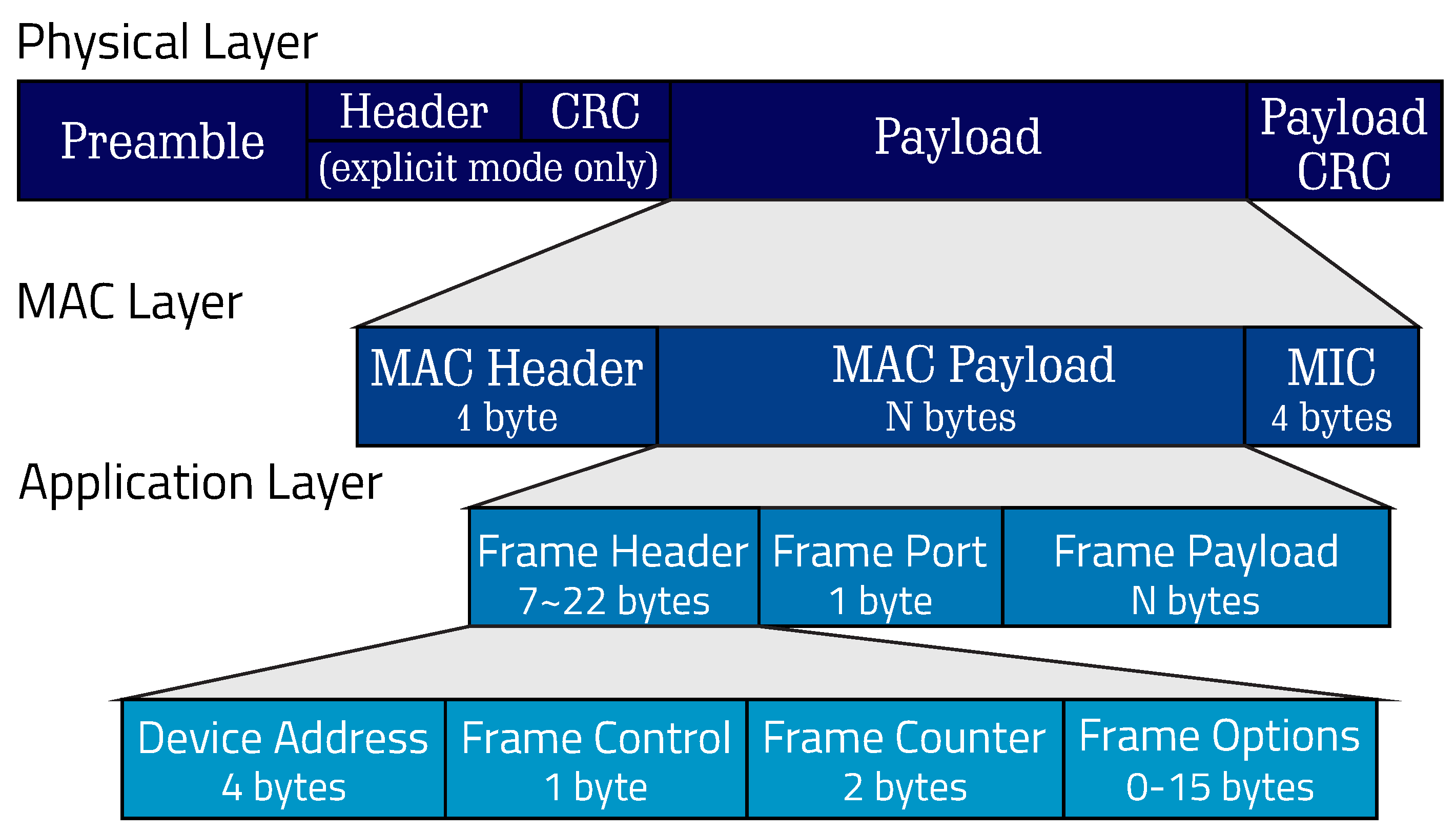



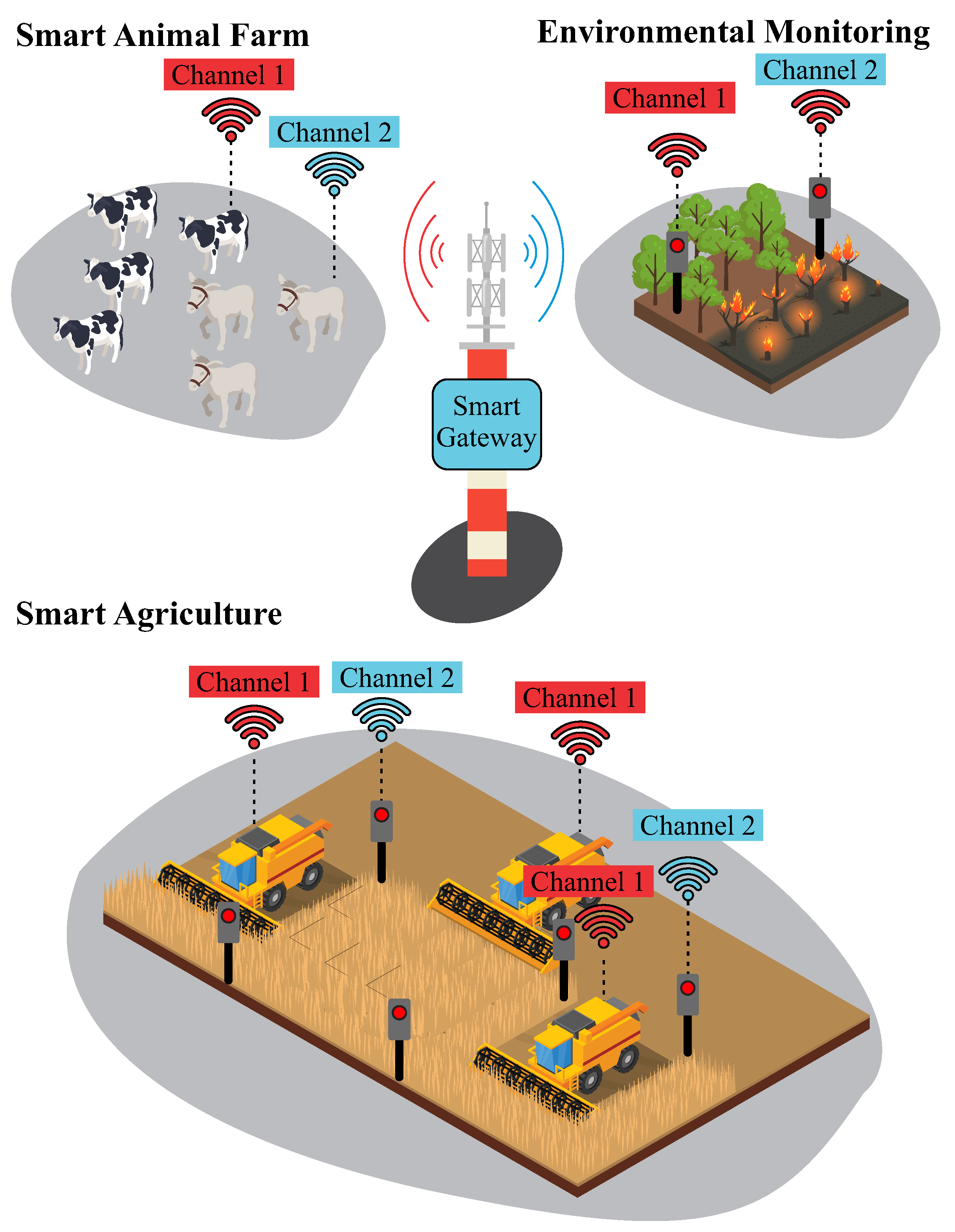


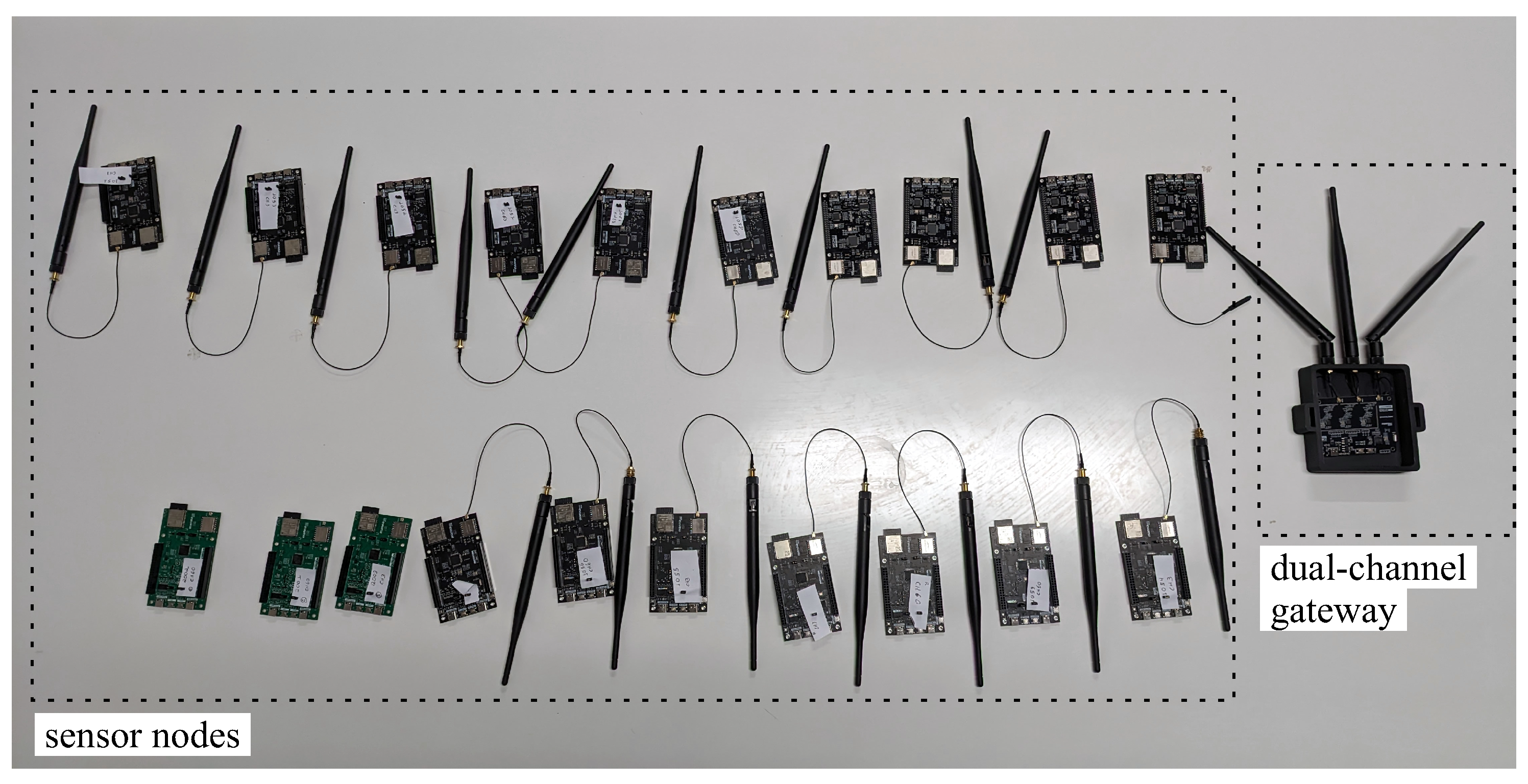
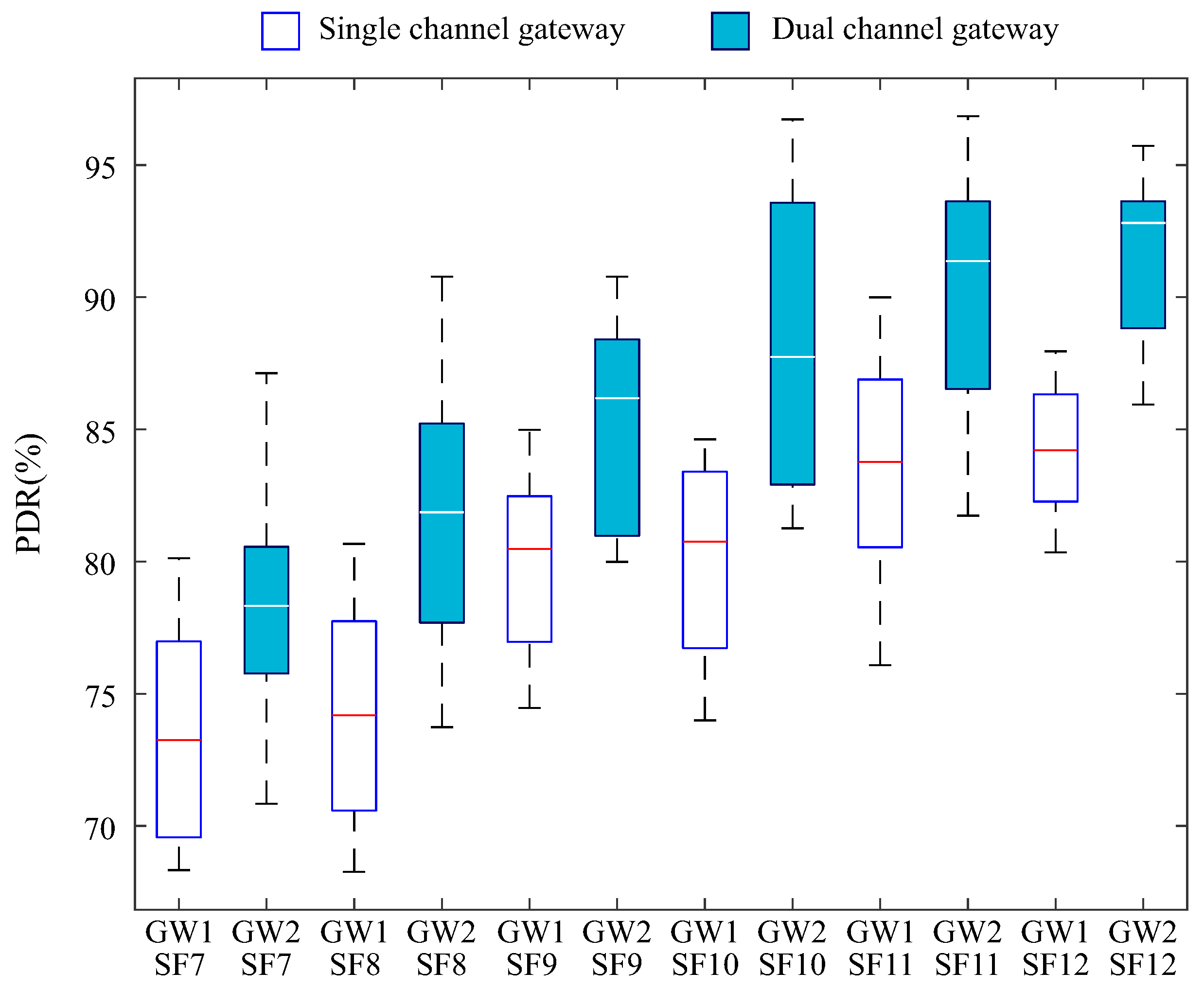
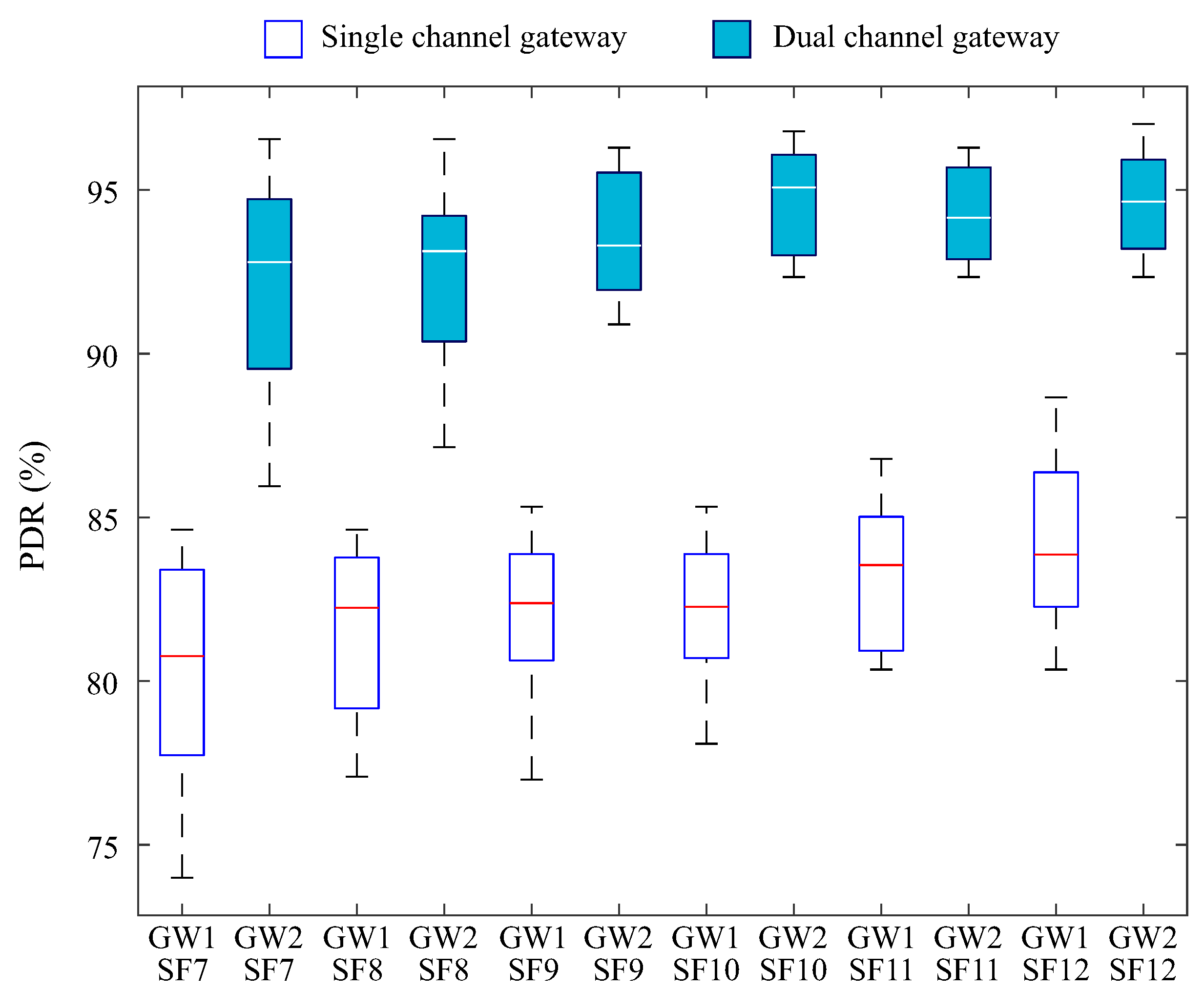
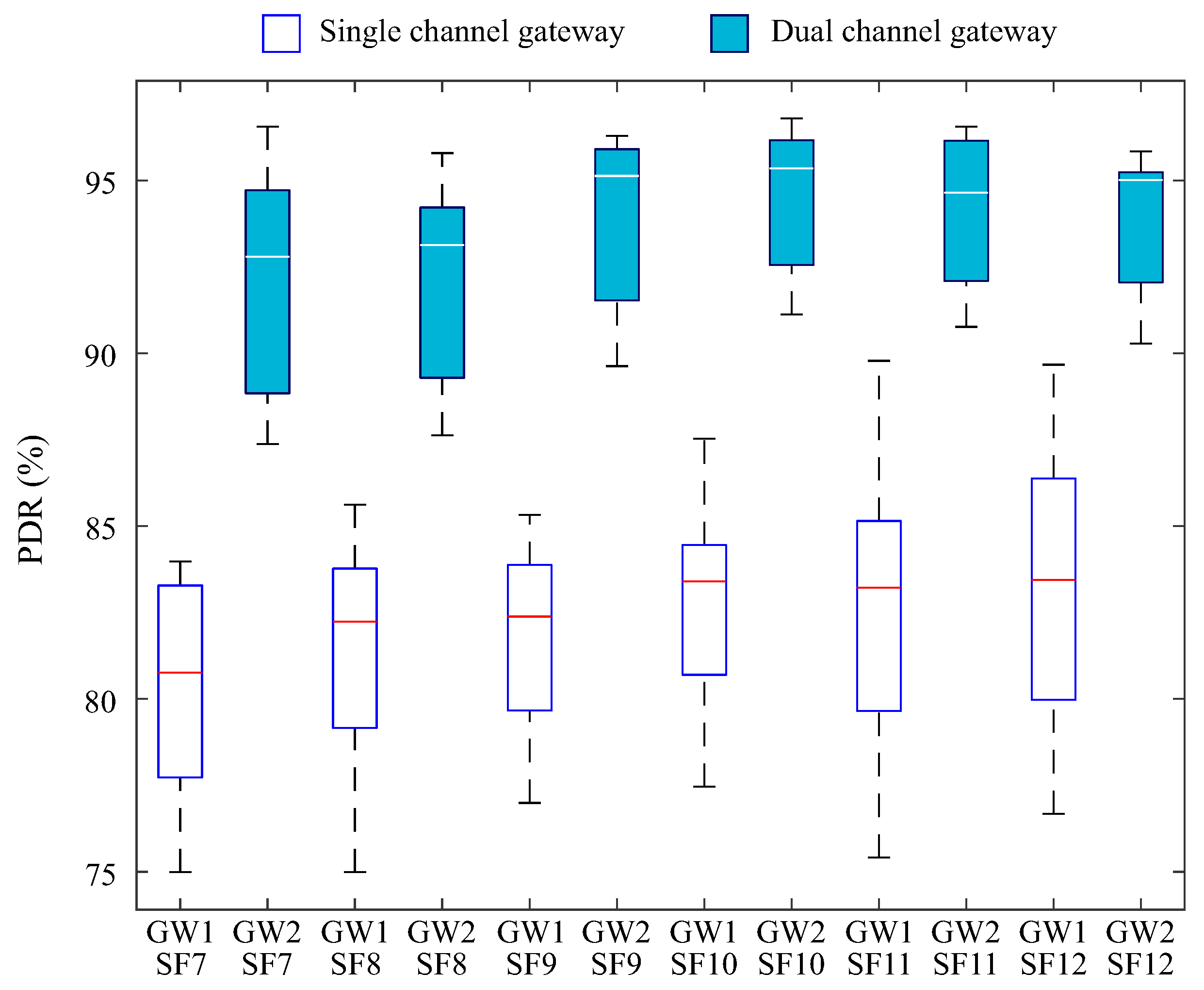

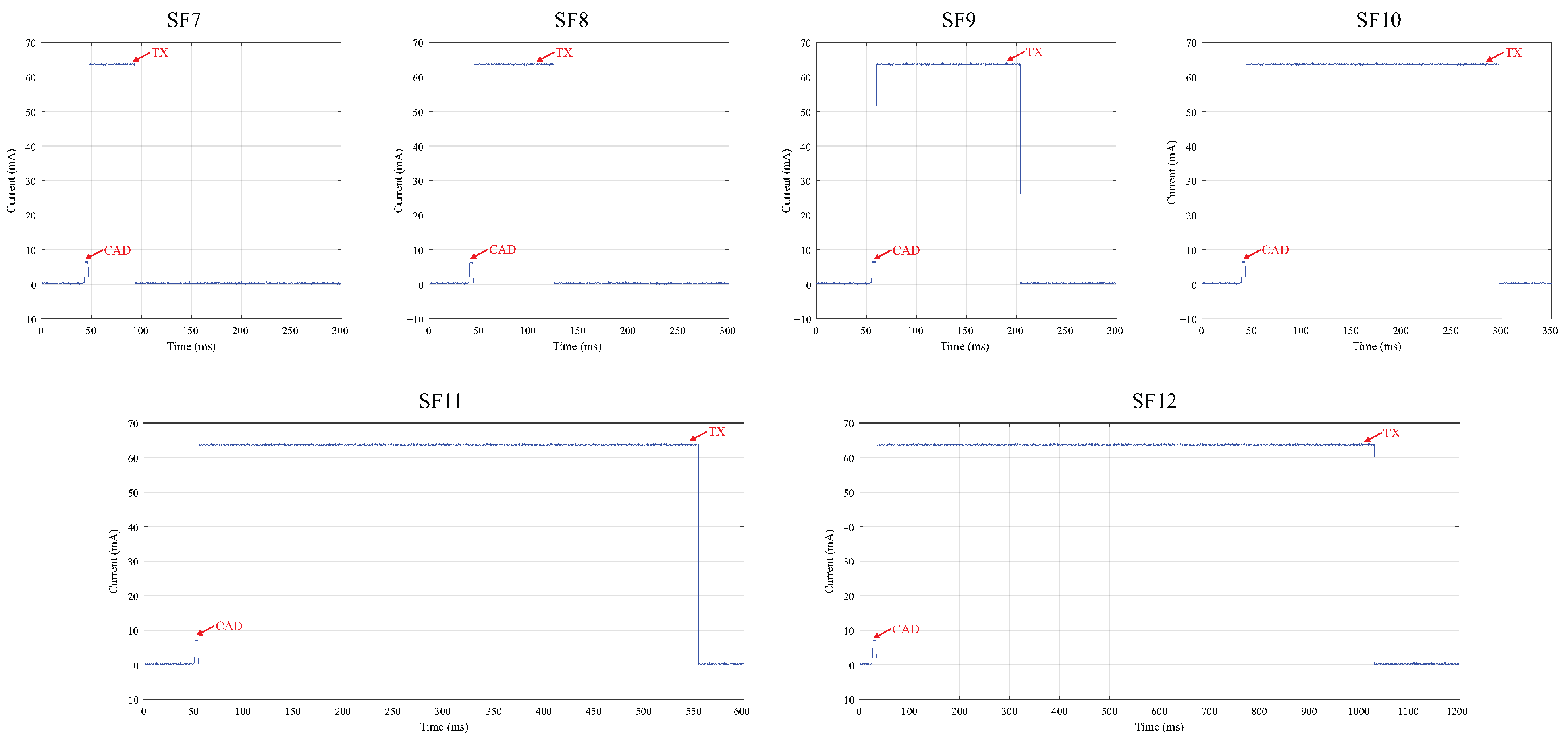
| Ref. | Hardware ou Software | Multiple Channels | Objective | Method/Approach | Benefits/Results |
|---|---|---|---|---|---|
| [34] (2019) | Software | Yes | Improve IoT gateways in terms of scalability, latency, and resource utilization. | Utilization of microservices and lightweight virtualization with Docker. | Distributed and modular processing at the network edge (edge computing). |
| [7] (2020) | Software | Yes | Optimize adaptive channel allocation in LoRa networks. | Adaptive allocation of multiple channels with different bandwidths. | Reduction in interference, retransmissions, and energy savings. |
| [20] (2021) | Hardware | No | Propose a multiprotocol gateway for IoT. | Integration of ZigBee and LoRa. | Interoperability between different protocols and performance optimization. |
| [35] (2022) | Software | Yes | Improve the scalability of LoRaWAN networks. | A new medium access control mechanism called Longest First Slotted CSMA (LFS-CSMA). | Optimization of channel utilization and reduction in collisions. |
| [9] (2023) | Software | Yes | Prevent collisions in dense networks. | Proposes a Collision Avoidance by Neighbor Listening (CANL) method that uses neighbor node listening. | Ongoing transmission monitoring and improved communication reliability. |
| [22] (2023) | Software | No | Evaluate the performance of unslotted ALOHA. | Analysis of the capture effect and multiple collisions. | Improved efficiency in multiple collision scenarios. |
| [4] (2024) | Software | Yes | Evaluation of collision avoidance algorithms. | Comparison between TDMA and CSMA. | TDMA demonstrates superior performance in collision prevention, while CSMA shows greater flexibility and scalability. |
| [21] (2024) | Software | No | Improve channel activity detection (CAD). | Enhance the scalability of LoRa networks by improving channel activity detection. | Reduction in collisions and better spectrum utilization. |
| [2] (2024) | Software | No | Development of a protocol with asynchronous downlink. | CSMA/CA with an asynchronous scheme for downlink. | Reduction in latency and increased network efficiency. |
| [8] (2024) | Software | Yes | Optimized channel selection in LoRaWAN networks. | Utilization of machine learning for optimized channel selection. | Reduction in interference and improved communication efficiency. |
| Category | Requirement | Justification | Proposed Element for the Model |
|---|---|---|---|
| Hardware | Multiple simultaneous reception channels. | To reduce collisions and increase scalability in dense networks. | Multiple LoRa transceivers (SX126x). |
| Hardware | Capability to perform CAD without compromising packet reception. | Reduction in collisions during gateway-to-sensor node transmissions. | LoRa transceiver dedicated to CAD (SX126x). |
| Hardware | Time synchronization without Internet access. | To enable packet ordering and reception window control. | GPS (MAX-M10), RTC + TCXO (DS3231). |
| Hardware | Processing and network management unit. | Local processing for network management and decision-making. | ESP32-S3 (MPU), with support for TensorFlow Lite and ESP-DL. |
| Hardware | Expandable memory. | Support for expanding local data storage. | External FLASH and RAM memory. |
| Hardware | Wired and wireless network interface. | Flexibility for Ethernet or Wi-Fi connectivity. | Ethernet PHY e Wi-Fi. |
| Software | Compatibility with real-time operating systems. | Efficient management of concurrent tasks, interrupt control, and process prioritization in the gateway. | ESP32-S3 microcontroller, with native support for low-cost FreeRTOS. |
| Software | Support for embedded AI frameworks. | Local execution of lightweight AI models for real-time analysis and autonomous decision-making. | Vector acceleration unit of the ESP32-S3 for supporting AI libraries (TensorFlow Lite). |
| Devices | Scenario 2 | Scenario 3 |
|---|---|---|
| Node 01 | 1.4 | 1.3 |
| Node 02 | 1.3 | 1.3 |
| Node 03 | 1.3 | 2.0 |
| Node 04 | 1.3 | 1.3 |
| Node 05 | 1.4 | 1.4 |
| Node 06 | 1.3 | 1.3 |
| Node 07 | 1.4 | 1.4 |
| Node 08 | 1.4 | 2.0 |
| Node 09 | 1.4 | 2.0 |
| Node 10 | 1.4 | 1.4 |
| Node 11 | 1.3 | 1.3 |
| Node 12 | 1.3 | 1.4 |
| Node 13 | 1.3 | 1.3 |
| Node 14 | 1.4 | 2.0 |
| Node 15 | 1.3 | 1.3 |
| Node 16 | 1.3 | 1.3 |
| Node 17 | 1.3 | 2.0 |
| Node 18 | 1.3 | 1.3 |
| Node 19 | 1.3 | 1.4 |
| Node 20 | 1.4 | 1.5 |
| Average | 1.34 | 1.51 |
Disclaimer/Publisher’s Note: The statements, opinions and data contained in all publications are solely those of the individual author(s) and contributor(s) and not of MDPI and/or the editor(s). MDPI and/or the editor(s) disclaim responsibility for any injury to people or property resulting from any ideas, methods, instructions or products referred to in the content. |
© 2025 by the authors. Licensee MDPI, Basel, Switzerland. This article is an open access article distributed under the terms and conditions of the Creative Commons Attribution (CC BY) license (https://creativecommons.org/licenses/by/4.0/).
Share and Cite
Bine, W.I.S.; Aylon, L.B.R. Design of a Low-Cost Gateway with LoRa Technology Serving Multiple Devices. Sensors 2025, 25, 4948. https://doi.org/10.3390/s25164948
Bine WIS, Aylon LBR. Design of a Low-Cost Gateway with LoRa Technology Serving Multiple Devices. Sensors. 2025; 25(16):4948. https://doi.org/10.3390/s25164948
Chicago/Turabian StyleBine, Wuigor I. S., and Linnyer B. R. Aylon. 2025. "Design of a Low-Cost Gateway with LoRa Technology Serving Multiple Devices" Sensors 25, no. 16: 4948. https://doi.org/10.3390/s25164948
APA StyleBine, W. I. S., & Aylon, L. B. R. (2025). Design of a Low-Cost Gateway with LoRa Technology Serving Multiple Devices. Sensors, 25(16), 4948. https://doi.org/10.3390/s25164948






